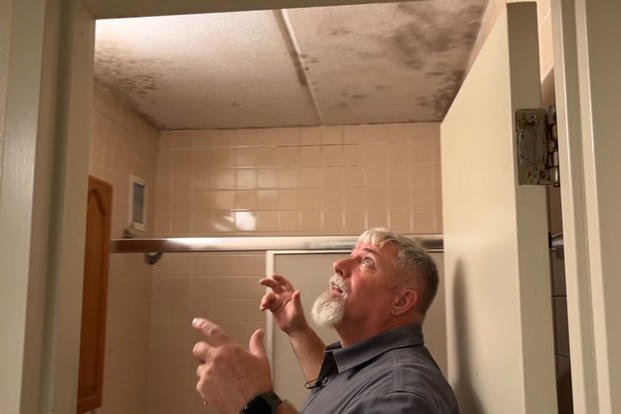The Pentagon will have to set military-wide standards for what makes barracks habitable under the defense policy bill that was signed into law late last week.
Requiring minimum standards for habitability is one of several ways this year's National Defense Authorization Act, or NDAA, seeks to improve barracks conditions, which have come under increasing scrutiny from lawmakers over the past year amid growing evidence of deplorable living conditions for junior service members.
President Joe Biden signed the NDAA into law late Friday afternoon. The wide-ranging bill covers everything from endorsing the annual military pay raise to facilitating medical studies of psychedelic drugs to scaling back diversity programs.
Read Next: The Top 10 Military.com News Stories of 2023
Also included in this year's NDAA are several reforms for barracks that come after a Government Accountability Office report documented squalid living conditions, including overflowing sewage, rampant mold, bedbug infestations and squatters.
The GAO report bolstered previous anecdotal evidence and news reports about rundown, moldy barracks. The report infuriated lawmakers, who demanded accountability and a culture change within the military that pays more attention to living conditions.
"If I would have had these conditions in any of our barracks, I would have gotten fired," Rep. Don Bacon, R-Neb., a retired Air Force brigadier general who heads a House Armed Services Committee quality-of-life panel, said in September following the revelations.
While military officials have acknowledged falling short in maintaining their barracks, some have continued to deny that there are systemic issues even after the GAO report. Top officials have also largely attributed barracks woes to funding issues. The Army, which owns the lion's share of barracks in the military, has said it plans to ask Congress for $4 billion to renovate and build new housing.
In the meantime, Congress is mandating several changes to the way the military thinks about the barracks. Most prominently, the NDAA requires the secretary of defense to establish military-wide minimum standards for assigning service members to barracks.
The standards will cover the buildings' condition, habitability, health and environmental comfort, safety and security, and "any other element the secretary of defense determines appropriate," according to the bill text.
Clarifying department-wide minimum standards for health and safety of the barracks was one of the key recommendations in the GAO report.
The standards can be waived only by a service secretary, according to the bill. The services will have 30 days from when the Pentagon establishes the standards to issue their own guidance on them.
The Pentagon will also have to certify to Congress every year that the cost of repairing a barracks facility isn't more than 20% of what it would cost to replace the building altogether. And it will have to create a military-wide index of the condition of all barracks, as well as a department-wide maintenance work order system.
For barracks that are substandard, the bill seeks to give the military more flexibility to replace them quickly by launching a five-year pilot program that will allow the services to dip into their operations and maintenance funding or unspecified minor military construction funding to build new housing.
The Pentagon will also have to establish military-wide design standards for barracks that stipulate, among other things, the minimum amount of floor space rooms can have and the quality of construction material that must be used, according to the NDAA. The military services will have two years from when the standards are issued to comply.
The bill also makes it harder to waive any minimum standards for privacy and configuration of the barracks by raising the waiver approval authority to the service secretaries. And it mandates that a civilian be put in charge of managing the barracks at each base's housing office, with limited exceptions for service members whose occupational specialty is focused on barracks management.
The reforms in this year's NDAA could be just the start of more sweeping changes. The House Armed Services Committee’s quality-of-life panel launched this year will make recommendations to include in next year's defense bill. Bacon and panel members have said housing will be one of its key priorities.
Related: Biden Signs Law Backing Military Pay Increase for 2024. Here's How Much More You'll Get.















